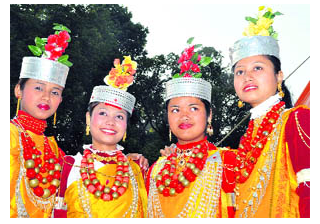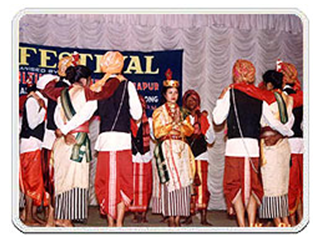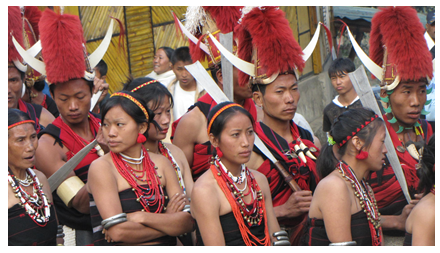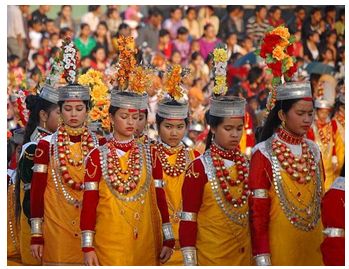FOLK DANCES OF MEGHALAYA
Contents
· Introduction
· Shad Sukmynsiem or Weiking dance
· Shad Nongkrem or Pomblang Nongkrem
· Doregata
· Pomelo or 'Chambil Mesara'
· Do Dru-su'a
· Laho dance
Introduction
Traditional folk dances in the state of Meghalaya are generally held in public places in the open ground. Different communities have different dance forms for instance, Khasis, Garos and Pnars.
Shad Sukmynsiem or Weiking dance
Also known as Shad Weiking, Shad Suk Mynesiem literally means ‘Dance of the Blissful Heart’. The dance is organised by the Seng Khasi, Khasi religion, for a period of three days. The dance is usually organised during the month of April and it is open to all unmarried men and women, without any religious bar.
The men dress up in colourful silk dhotis, plumed turban and coats. They dance with sword or spear in one hand and plume in the other. The maidens dress up in magnificent silk robes and play the role of Apsaras or angels. The maidens form the inner circle and dances with tiny steps at a time, in groups of twos’ and threes’. The outer circle is formed by the men, who form a protective layer, carrying the swords and the spears. The dance is portrayed as form of blissful expression of the heart.
Shad Nongkrem or Pomblang Nongkrem
Also known as Pomblang Nongkrem, Shad Nongkrem is a dance dedicated to Goddess Ka Blei Synshar, to propitiate her for a bounteous harvest and prosperity. The festival is celebrated in the month of November and is performed by the Syiem of Khyrim and the high priest. Goats and cocks are sacrificed as offerings during the ceremony. After the ceremony is complete, the Nongkrem dance begins, which is performed by the virgins from the Syiem house. After the royal dance, the dance of the U Khun U Raiot of Hima Khyrim starts and it lasts for three days.
Doregata
Another, very popular dance ceremony in Megahalaya is the Doregata, performed by the Khasis. In this dance, the women try to knock off the turban of the male partners, by only using the head. No other body part is allowed to be used during this effort.
Pomelo or 'Chambil Mesara'
Also known as Chambil Mesara, the Pomelo Dance Festival is very popular amongst art connoisseurs and fun-seeking holiday makers. In this dance, a Pomelo or any other fruit is attached to the waist through a cord. The dangling cord is then whirled around the body, without any perceptible movement of the hips. It is especially popular amongst the Khasi tribals.
Do Dru-su'a
The Do Dru-su’a is a traditional dance form of the Garo tribe. In this dance, two women dance like doves pecking at each other.
Laho dance
The Laho dance is very popular among the Pnar tribe. In this dance form two men dance on either side of a woman. The dance is accompanied by a stand-up comedian who has the gift of impromptu humorous recitations.




View/s: 51011 Comment/s: 0
